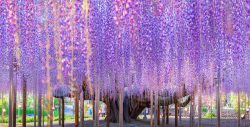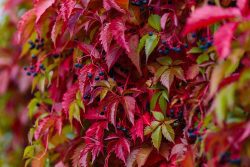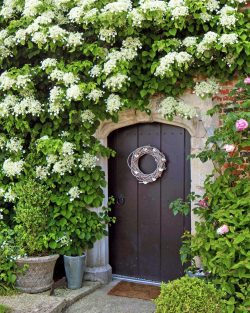Climbing plants. They’re probably all over your city, growing up brick walls, over wooden structures, and even up the sides of trees.
In the spring and summer, climbing plants can quickly become the most eye-catching, useful plant in your landscape – if you know which ones to use and, more importantly, how to properly maintain them.
What are climbing plants?
They’re exactly what they sound like: plants that climb.
Most climbing plants (hereafter referred to as “climbers”) require some sort of structure to hang on to, but some, in the absence of a wall or trellis, will simply grow along the ground (ivy, for example). Some can grab right onto vertical walls or columns; others require a structure with a post or lattice, such as an arbor, pergola, or trellis.

An ivy-covered brick house. Ivy can look beautiful, but it can also be high-maintenance.
Climbers can be used ornamentally, adorning otherwise bare façades with foliage and colour. They can be functional, growing up a trellis or structure to add privacy to your yard or garden. Some climbers, like kiwi and grapes, bear fruit under the right conditions. Climbers are endlessly useful and usually gorgeous, adding unity and vertical appeal to your landscapes in ways few other plants can.
However, left to its own devices, a climber can be your garden’s worst enemy. They can grab onto other plants, choking them out or shading them from the sun. They can find their way into buildings. Large, well-established climbers like wisteria can even de-stabilize small wooden structures, like arbors, trellises, and fences.
Make no mistake: a climbing plant can be high maintenance if you aren’t diligent with pruning.
Our 5 Favourite Climbing Plants
1. Evergreen Clematis (Clematis armandii)
Clematis comes in many different varieties, but a true standout among them is Evergreen Clematis (Clematis armandii). With stunning white flowers in spring and vivid year-round foliage, this handy climber is the perfect balance of ornamental and functional – especially if you want to use it as a privacy screen. It’s less invasive and aggressive than most of its other evergreen counterparts (such as english ivy), but still grows very quickly and requires regular pruning.

2. Japanese Wisteria (Wisteria floribunda)
An ornamental standout, Wisteria is fast-growing and truly gorgeous in the spring and summer, when it becomes absolutely enveloped in pale purple flowers. Because it grows so quickly, it needs to be trimmed regularly. It also loses all flowers and leaves in winter, so its year-round appeal is limited.

3. Virginia Creeper (Parthenocissus quinquefolia)
If you need a climbing plant that adds autumn colour to your landscape, nothing is better than a Virginia creeper, the leaves of which turn violent crimson in early-mid fall. It can be used as a climbing vine, trailing vine, or a ground cover, and, unlike some other vines and ivies, it has adhesive tips, meaning it can attach to walls and structures without any risk of finding their way into the building. On the negative side, Virginia creeper berries are mildly poisonous, and its sap can be a skin irritant, so exercise caution.
4. Climbing Hydrangea (Hydrangea anomala)
Like Virginia creeper, climbing hydrangeas can climb without a trellis or lattice; its branches have small holdfasts which allow it to grip and surface. Another deciduous vine, climbing hydrangeas have white flowers in the spring and summer, but lose all foliage in winter. They’re slow-growing, which means it can take years to reach an ideal size; on the plus side, that makes them lower maintenance than most other climbers.
5) Star Jasmine (Trachelospermon jasminoides)
A fragrant and beautiful climber, star jasmine is a quick-growing deciduous vine that loves summery conditions and warm weather. It’s evergreen, but has a lower tolerance for freezing winter weather than Evergreen Clematis.
Bonus: Bougainvillea (Bougainvillea)
Though bougainvillea is a beautiful tropical plant with wildly colourful bracts, it’s not recommended for our climate, preferring frost-free areas where the temperate remains year round at at least 5 degrees Celsius. It’s drought tolerant, colourful, attracts wildlife, and grows in a very broad variety of colours, but it also has sharp thorns and is mildly poisonous if ingested. We’d grow it here if we could!
Going Forward
If you’re thinking about adding climbing plants to your garden, carefully consider what you’re looking for, as well as whether or not you’ll have time to maintain them. Though they’re beautiful additions to any landscape, they can be a handful!
If you have any questions, need recommendations, or help designing and installing your garden, our accredited team can help you out! Get in touch if you need any help or advice.






Comments are closed here.